 Is coconut healthy?
Is coconut healthy?
Shouldn’t I avoid coconut because it is so high in saturated fat?
What is the difference between light and full-fat coconut milk?
We get so many questions about all of the coconut-related products, so we want to attempt to answer some of the most frequent questions here.
There is a lot to cover on this topic, so we are breaking this up into two coaching tips (to hopefully keep it from being too overwhelming!). If you have questions, please let us know and we can address them in “Part 2” next week!
So many coconut products!
Coconut products have been growing in popularity the past few years, and many of them are marketed as having “superfood” powers. See what we mean and pay attention during your next trip to the store. You will find everything from coconut oil to coconut milk to coconut water. And that’s not all…you will also see coconut flour, coconut sugar, creamed coconut, coconut cream, cream of coconut, coconut butter, coconut aminos, and more! It’s enough to make your head spin!
Remember when the only places you would find coconut were in Pina Coladas and Almond Joy candy bars?!
Where it all starts…
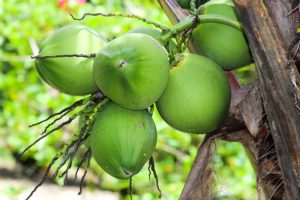 Most likely you know that coconuts grow in tropical areas on certain varieties of palm trees. And, most people are familiar with the brown, husky coconuts that you find at the store. This is actually not the outside layer of the fruit! Coconuts are a stone fruit, or a drupe, and when they come off the tree, the outer layer is typically hard and green (this called the exocorp). This outer layer has to be removed (or shucked) to get to all the goodness inside.
Most likely you know that coconuts grow in tropical areas on certain varieties of palm trees. And, most people are familiar with the brown, husky coconuts that you find at the store. This is actually not the outside layer of the fruit! Coconuts are a stone fruit, or a drupe, and when they come off the tree, the outer layer is typically hard and green (this called the exocorp). This outer layer has to be removed (or shucked) to get to all the goodness inside.
And this is no easy task – during our recent trip to Puerto Rico, our host Frankie showed us how to shuck the coconut with his machete (and I used to think a Chef’s knife was intimidating! Let’s just say I would have lost a few fingers!).
Once this outer green layer is removed, you get to the brown, hairy  husk (this is called the mesocarp). This layer protects the fruit inside. Then, you finally get to the exterior of the seed (this is called the endocarp). Once you open the seed, it is time to enjoy the white layer of coconut “meat” and the electrolyte-loaded juice inside.
husk (this is called the mesocarp). This layer protects the fruit inside. Then, you finally get to the exterior of the seed (this is called the endocarp). Once you open the seed, it is time to enjoy the white layer of coconut “meat” and the electrolyte-loaded juice inside.
If you buy a whole coconut, it should be very hard. You should be able to hear the juice inside when you shake it. You can store coconuts in a cool, dry place for weeks or even months. If you buy shredded coconut, we typically store it in the fridge, or you can store it in the freezer for up to six months.
Is it healthy? What about the saturated fat?
Coconuts contain many nutrients that support your immune system, including iron, manganese, magnesium, zinc, selenium and potassium. They are also a good source of fiber.
The fat in coconuts is where it gets a little controversial.
For example, 2 Tbsp. of unsweetened shredded coconut contains 10 grams of total fat, which includes 9 grams of saturated fat. Without getting too technical, it is useful to know that the primary fatty acid it contains is lauric acid, which is a medium chain saturated fat that behaves differently from the saturated fat in meat and dairy. Some studies have shown this fat is quickly metabolized by your body and doesn’t promote inflammation or clog your arteries the same way as other saturated fats.
The various coconut products can contain a lot of calories and added sugars. For example, 2 Tbsp of cream of coconut (a common ingredient in Pina Coladas) contains 17 grams of added sugar (over 4 teaspoons!). This is why it is so important to read those ingredient labels!
We encourage you to enjoy coconut and certain coconut-related products in your diet, but don’t go overboard. And, while coconut provides some health-promoting benefits, it should not be viewed as a magical “superfood.”
What about coconut oil?
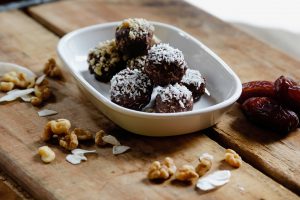 Coconut oil can be an excellent option for certain food preparations. Because it is solid (or at least has a firmer texture) when cold or at room temperature, it works great in recipes like the Chocolate Chia Energy Bites, Almond Butter Bites, Chocolate Peanut Butter Cups and the Oatmeal Cookie Parfait Cups, where it helps hold things together.
Coconut oil can be an excellent option for certain food preparations. Because it is solid (or at least has a firmer texture) when cold or at room temperature, it works great in recipes like the Chocolate Chia Energy Bites, Almond Butter Bites, Chocolate Peanut Butter Cups and the Oatmeal Cookie Parfait Cups, where it helps hold things together.
If you remember our coaching tip on cooking oils, we talked about the difference between cold-pressed, expeller-pressed and refined oils. Cold-pressed oils retain the most nutrients while refined oils retain the least amount of nutrients.
This is also true for coconut oil. Coconut oils that are cold-pressed, or unrefined, are preferrable from a nutrition standpoint. Compare this to coconut oils that are refined, exposing them to heat and chemicals, which strip the nutrients and alter the composition of the fatty acids. Keep in mind, cold-pressed oils will have a lower smoke point (around 350 degrees) vs. refined oils (a little over 400 degrees). Also, some people will detect a slight coconut flavor with unrefined, whereas refined versions have a more neutral taste and aroma because of the processing that has taken place. (When sautéing or roasting, we occasionally use coconut oil, but our “go-to” is extra virgin olive oil.)
From a nutrition perspective, compared to other refined oils, cold-pressed coconut oil is probably a better option (if used occasionally). However, if you are comparing coconut oil to a quality extra virgin olive oil, the EVOO would be the better choice.
What about light vs. regular (or full-fat) coconut milk?
Canned coconut milk is made from the liquid of grated coconut meat. It is a great addition to many meals, especially curries, soups, sauces, and even sweet treats. The grated meat is steeped in hot water, and then squeezed through a cheesecloth. This process produces three main products, each of which has a different coconut to water ratio:
 Coconut cream has the least amount of water…it is thicker and can be used as a substitute for dairy cream or half and half. It has the highest fat content (about 20% fat). You can use coconut cream to make your own whipped cream, and it can also be a fantastic addition to certain curries, soups, smoothies and other desserts like the Coconut Cream Tiramisu.
Coconut cream has the least amount of water…it is thicker and can be used as a substitute for dairy cream or half and half. It has the highest fat content (about 20% fat). You can use coconut cream to make your own whipped cream, and it can also be a fantastic addition to certain curries, soups, smoothies and other desserts like the Coconut Cream Tiramisu.- Full fat coconut milk is thinner than coconut cream, but still has a rich and creamy consistency. Because it has more water, its fat content is typically 10% to 15%. If you are looking for a thicker consistency for your curries, sauces or dressings, it can be a good choice.
- Light coconut milk has a thinner consistency because it has the lowest coconut to water ratio. Its fat content is typically less than 10%. It has the fewest calories, fat, and saturated fat and works well in many recipes (although it doesn’t produce quite the same richness in your meals as the full fat variety).
A few other considerations:
 If you look at the ingredient labels, these products often contain a thickener such as guar gum. However, some stores do carry coconut cream and full fat coconut milk without the added thickener.
If you look at the ingredient labels, these products often contain a thickener such as guar gum. However, some stores do carry coconut cream and full fat coconut milk without the added thickener.- Once you open a can of coconut milk, it is best to store any leftovers in a separate sealed container and use within 4-6 days.
- You can actually get about 1/2 cup of coconut cream from a can of full fat coconut milk. All you have to do is refrigerate your coconut milk overnight. A thick layer of coconut cream will rise to the top and can be skimmed off when you open the can. It will be thick and higher in fat, just like the canned coconut cream you would buy from the store. A quick tip we have learned: turn the can upside down when you put it in the fridge. The liquid will separate and, in our experience, it can be difficult to remove the bottom of the can. So, by refrigerating the can of coconut milk upside down, the liquid will now be on the top as you pull it out of the fridge and turn it right-side up. You can remove the top of the can and pour out the liquid, and then easily scoop out the cream from the bottom of the can.
 You can also use coconut cream to make coconut milk. Simply mix 2 Tbsp of coconut cream into 3/4 cup of water and you will have 1 cup of coconut milk.
You can also use coconut cream to make coconut milk. Simply mix 2 Tbsp of coconut cream into 3/4 cup of water and you will have 1 cup of coconut milk.- Don’t confuse coconut cream with cream of coconut. Coconut cream is simply coconut and water (and maybe a thickener), whereas cream of coconut is loaded with sugar (it is a common ingredient in Pina Coladas and other cocktails).
The choice of full fat vs light coconut milk really comes down to a personal preference based on the tradeoff between calories, fat and desired creamy texture.
If you are looking for some flavor-loaded recipes to enjoy coconut milk, check these out:
- Thai Inspired Autumn Hummus
- Creamy Fruit Salad
- Cabbage & Summer Squash Pear Salad
- Thai Curry Roasted Veggies
 Smoky Braised Butternut Squash
Smoky Braised Butternut Squash- Sausage, Potato & Kale Soup
- Bacon Butternut Squash Soup
- Mulligatawny Soup
- Moroccan Vegetable Curry
- Summer Vegetable Curry
- Eggplant & Mushroom Curry
- Turkey & Spinach Curry (great way to enjoy leftover Thanksgiving turkey!)
- Irish Pork & Fruit Curry
- Cauliflower Mango & Spinach Curry with White Fish
- Slow Cooker Thai Pork Sandwiches
- Slow Cooker Thai Inspired Pulled Pork
 Slow Cooker Thai Chicken Stew
Slow Cooker Thai Chicken Stew- Salmon Taco Lettuce Wraps
- Pina Colada Banana Ice Cream
- Lemony Chia Seed Pudding
Next week, we will cover more about some of the other coconut-related products, such as coconut flour, coconut sugar, coconut water, coconut aminos, creamed coconut, and more!
What questions do you have?
Let us know and we will do our best to answer them in next week’s coaching tip!
 LEARN MORE ABOUT THE NAPKIN!
LEARN MORE ABOUT THE NAPKIN!

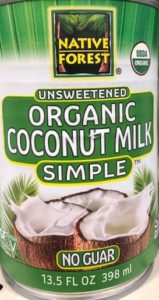
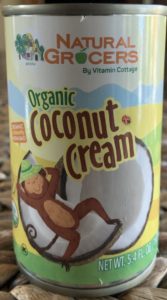
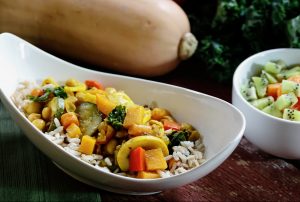
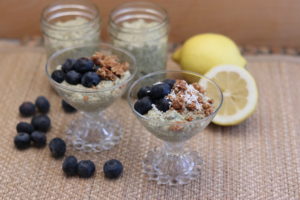
What about such as Clean MCT from Amazon. It states that ultra refined to extract only C8 caprylic acid.
Hi Salena,
We know there are a lot of internet conversations about fractionated coconut oil, extracting just the MCT oil, being amazing for the brain…. but when you ask for the science to back up the claims, it’s just not there!. Everyone is looking for the next great thing (especially for brain health). And MCT supports ketosis, which we don’t recommend, because it is so highly disrupting to our gut microflora. That said, if your research leads you to feeling confident with a product like this, then don’t let us talk you out of it! We just know a lot of people use products like this for a while, and realize,real food is cheaper, more realistic, and just plain healthier. We really like REAL whole coconuts first, and minimally processed coconut oil second… the way nature intended them! Thanks for your question and we hope that helps!